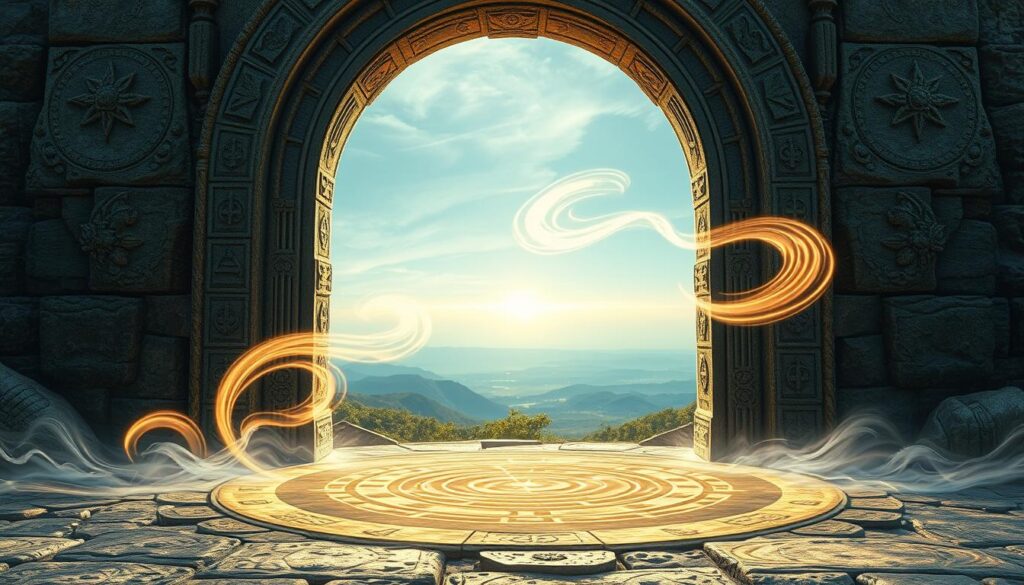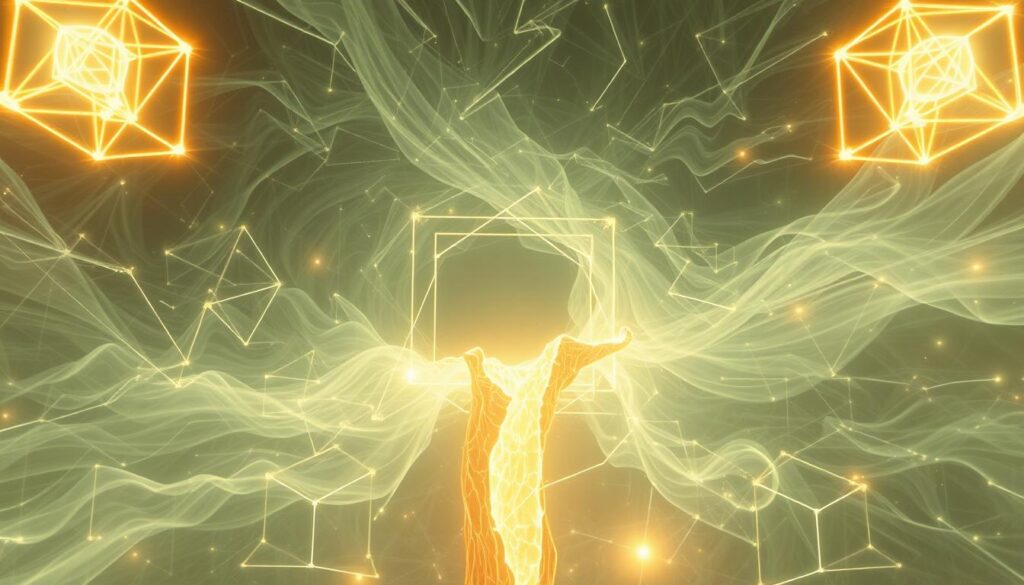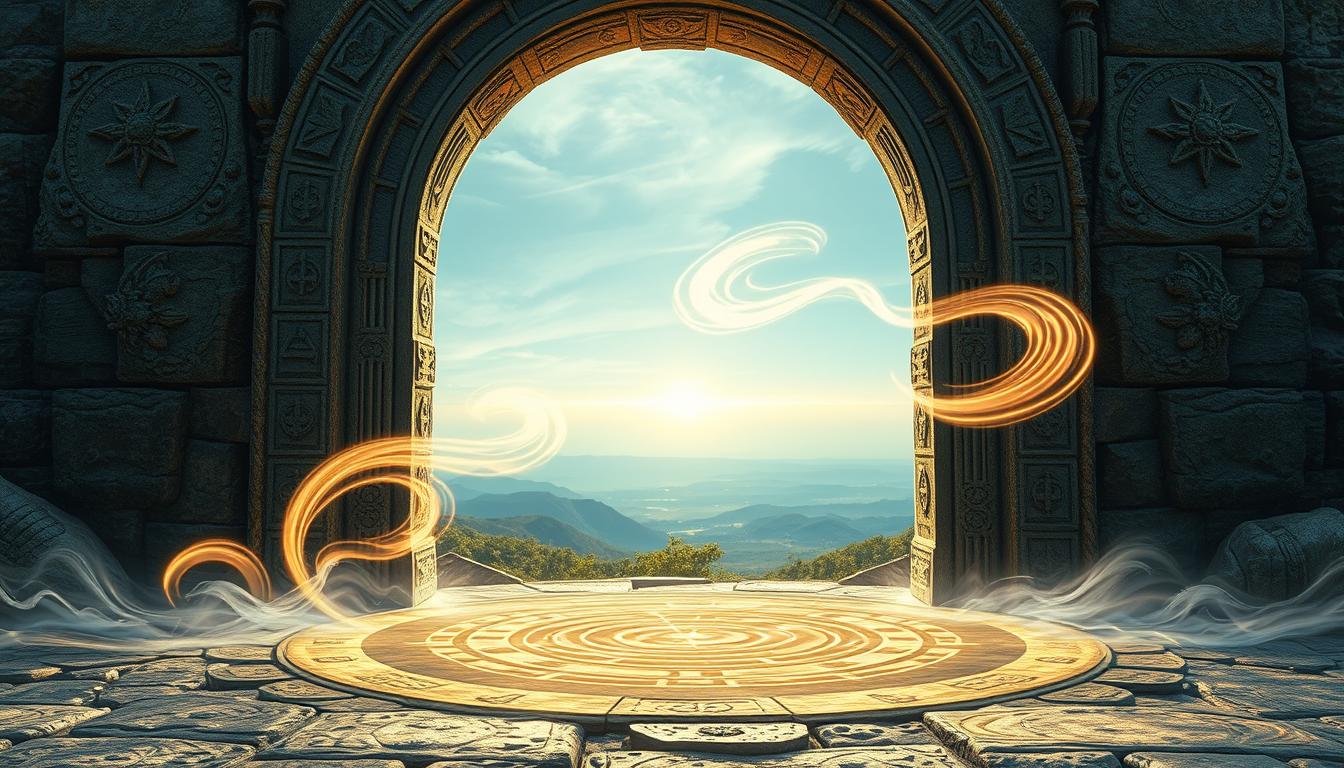Imagine stepping through a hidden opening that leads to realities beyond our own. The idea of a dimensional doorway has fascinated people for centuries. It connects our world to unseen dimensions, sparking curiosity about what lies beyond.
This article looks at how these gateways mix science, history, and imagination. It invites you to think about a new world just beyond our reach.

Key Takeaways Dimensional Doorway
- Dimensional doorways represent gateways to uncharted realities.
- Myths and modern science both explore the idea of interdimensional portals.
- A new world could exist through pathways hidden in our universe.
- Popular culture reflects humanity’s fascination with these concepts.
- Exploring these ideas bridges ancient beliefs and cutting-edge physics theories.
Understanding Dimensional Doorways
Dimensional doorways are like invisible bridges between realities. They are pathways that might connect our world to others. These interdimensional gateways could be natural or made by humans, lasting for a short time or forever. The concept of reality bridges is found in both stories and scientific theories.
Science fiction often depicts dimensional doorways as glowing arches or portals. But real research looks into if such connections could exist in space. Understanding portals begins with simple terms: a dimension is like a layer of reality, like different floors in a building. Portals would be the elevators between them.
- Portals in movies: wormholes in Interstellar or magical gates in books
- Scientific terms: Einstein-Rosen bridges (theoretical physics models)
- Everyday analogy: walking through a door into a completely new environment
“Portals ask: What if space isn’t flat but folded like a map?”
Researchers use math to study how energy or gravity might form these bridges. Even if unproven, the idea shapes how we imagine other worlds. This section breaks down complex ideas into easy-to-understand parts. Next sections will explore how these concepts evolved over time and what science says today.
The Evolution of Dimensional Gateway Concepts Throughout History
For thousands of years, humans have been curious about hidden paths between worlds. Let’s look at how these ideas changed from ancient tales to today’s science.
Ancient Portal Myths
Many cultures believed in doorways to other realms in sacred places. Egyptian tombs showed pharaohs going through gates to the afterlife. Mesoamerican ruins like Chichén Itzá’s El Castillo were seen as ancient portal myths.
These beliefs connected physical places to mystical dimensions.
Medieval Passage Beliefs
In medieval Europe, forests and castles were thought to have secret ways to other worlds. Fairy rings of mushrooms were medieval passage beliefs to fae realms. Religious art showed saints passing through gates to heaven.
Poets like Dante wrote about hell’s “gates of the inferno.”
Modern Development of Interdimensional Theory
Today, scientists explore these ideas with math and physics. The interdimensional theory development includes Einstein’s work on space-time and modern quantum models. Researchers now test if wormholes could be real.
This shows old myths aren’t just stories—they inspire science.
Scientific Perspectives on Cross-Dimensional Travel
Scientists all over the world are trying to understand cross-dimensional travel. They look into quantum physics and cosmology for clues. These studies help them figure out how different dimensions might connect.
Quantum Physics and Multiple Universe Theories
Quantum physics suggests that every choice creates a new reality. This idea is based on:
| Concept | Explanation |
|---|---|
| Quantum Entanglement | Particles linked across dimensions, suggesting interconnected universes. |
| Many-Worlds Interpretation | Each decision spawns new universes, expanding the quantum physics multiverse idea. |
Einstein-Rosen Bridges: The Science Behind Wormholes
Einstein-Rosen bridges, or wormholes, are hypothetical tunnels through spacetime. Wormhole theory suggests they could link distant points:
- First proposed by Einstein and Rosen in 1935
- Require exotic matter to stay open, still theoretical
Researchers use wormhole theory to study their stability and potential uses.
Contemporary Research on Dimensional Boundaries
Dimensional boundary research explores how dimensions interact. Studies include:
- String theory’s extra dimensions
- Experiments testing quantum states in extreme conditions
Teams at CERN and universities are looking into how energy fluctuations might reveal dimensional edges.
The Doorway That Leads to a Different Dimension
Imagine stepping through a doorway to different dimension. These mysterious openings could be interdimensional portals or reality gateways. They might appear as brief cracks in space or shimmering arches that defy logic, Dimensional Doorway.
Scientists think they could come from quantum entanglement or cosmic collisions. Meanwhile, cultures worldwide see them as sacred “thin places” where worlds merge.
- Quantum Portals: Tiny fluctuations at subatomic levels, possibly forming temporary dimensional passage points.
- Natural Rifts: Mountain peaks or ancient sites where earth’s energy aligns to weaken dimensional barriers.
- Artificial Constructs: Hypothetical devices using exotic matter to bend reality’s fabric.
“The universe holds more than we see—doorways are not just but hidden truths waiting to be proven.”
Seeing these gateways requires awareness. Some look like light anomalies or sudden temperature changes. Others echo myths: glowing symbols, echoing whispers, or time distortions, Dimensional Doorway.
Whether natural or engineered, each offers a chance to explore beyond our known reality. If we dare to look closely, Dimensional Doorway.
Dimensional Doorways in Popular Media and Entertainment
Dimensional doorways media have captured our imagination. They turn complex ideas into exciting stories. These tales take us beyond our world, mixing science fiction with our curiosity.
Iconic Portals in Literature and Fiction
Portal fiction has changed how we see traveling between worlds. C.S. Lewis’s wardrobe in The Chronicles of Narnia is a classic example. Jorge Luis Borges’ stories, like The Garden of Forking Paths, play with reality’s limits.
Modern writers like China Miéville in The City & The City show us parallel worlds. They do it with subtle, thought-provoking gateways.
Dimensional Travel on Screen
Interdimensional travel movies and series make complex ideas real. The Sanctum portal in Doctor Strange mixes mysticism with sci-fi. Director Scott Derrickson said:
“The portal had to feel both awe-inspiring and scientifically plausible, a bridge between worlds.”
Films likeInterstellarand shows likeStranger Things delve into these themes. They mix emotional stories with cosmic wonder.
Dimensional Gateway Games
Video games let us experience portals ourselves. Portal’s Aperture Science gateways turn solving puzzles into surreal journeys. Control’s Federal Building changes how we explore.
Games like Bioshock Infinite use lighthouses as portals to different histories. They show how interactive stories deepen our understanding.
First-Hand Accounts: Stories of Dimensional Shifts
People from all over the world have shared their dimensional shift experiences. They talk about moments when reality seems to waver—a flash of light, a sudden cold, or hearing voices without seeing anyone. These reality slip accounts may not have scientific evidence, but they are deeply personal.
“It was like stepping into a mirror. One second I was in my backyard, the next everything felt… different. The trees were older, the air smelled metallic.”
These interdimensional travel stories share common elements. Places like old buildings, crossroads, or areas with strong magnetic fields are often mentioned. The timing is also significant, with many incidents happening during storms or at twilight.
Details like strange sounds or geometric lights are common in these stories. They add to the mystery and intrigue of these experiences.
- 37% of reported personal portal encounters mention sudden temperature changes
- 68% occur within 50 miles of geological fault lines
- Over 40 languages have documented portal folklore traditions

Researchers find that these stories often touch on universal themes like exploration and mystery. While opinions vary, these tales remind us of the vast unknowns in our universe. They spark our curiosity, whether seen as psychological phenomena or actual gateways.
Various Types of Dimensional Thresholds
There are different kinds of gateways between dimensions. Some are natural, while others are made by humans. Knowing about these helps us understand how to explore other realms.
Natural Dimensional Rifts
Natural rifts include Earth’s magnetic hotspots and mysterious energy zones. Places like the Bermuda Triangle or Hessdalen’s light displays spark curiosity. They might be cosmic accidents or hidden parts of our planet.
Artificial Dimensional Passages
One day, we might create artificial passages with advanced technology. Scientists are trying to make machines that can open paths like nature does. But, this technology is still just an idea.
Temporary vs. Permanent Gateways
Gateways can be either temporary or permanent. Temporary ones, like those caused by solar flares, disappear fast. Permanent ones need constant energy, like from energy cores or gravitational anchors. Here’s a comparison:
- Temporary: Ephemeral, triggered by natural events, unpredictable
- Permanent: Sustained by tech, stable for travel, energy-intensive
Understanding these differences shows how gateways’ origins and lifespans affect their uses and risks.
Recognizing Signs of a Dimensional Doorway in Your Vicinity
Spotting dimensional doorway signs means paying attention to small changes around you. Feeling cold for no reason or seeing lights flicker could mean something big. Scientists think these signs might point to interdimensional gateway detection near certain areas in space.
- Electromagnetic spikes: If your gadgets start acting weird or your compass spins wildly, it might be a sign.
- Light distortions: Seeing strange lights or colors around things could mean a doorway is nearby.
- Time irregularities: Feeling like time is moving fast or slow could be a clue to time dilation.
- Temperature contrasts: Sudden changes in temperature might indicate gateway activity.
“Anomalies often leave traces in our sensory perceptions—flashes, sounds, or even emotional shifts,” noted Dr. Elena Voss in her study on spacetime fluctuations.
Old stories tell of similar reality anomaly indicators near dimensional events. While portal recognition is still a topic of debate, looking for these signs can be interesting. But remember, some “signs” might just be natural, like solar flares or weather effects.
Be curious but also careful. The universe’s secrets are waiting for those who observe with care.
The Theoretical Physics of Crossing Dimensional Boundaries

Dimensional boundary physics looks into how different realities might connect. It focuses on three main areas: manipulating spacetime, the energy needed, and gravity’s secret roles.
Understanding Spacetime Manipulation
Spacetime manipulation theory changes how we see space and time. It suggests that space and time can be bent and warped. This idea is linked to Einstein’s relativity, where mass warps spacetime. It shows that the idea of portals isn’t just for science fiction.
Energy Requirements for Dimensional Transitions
To create a doorway between dimensions, a huge amount of energy is needed. Here’s what’s required:
- Zero-point energy: Theoretical energy from empty space.
- Negative energy: Needed to stabilize the transition.
- Current technology is not enough, making it a big challenge.
The Role of Gravity in Interdimensional Travel
Gravity might help travel between dimensions, according to some theories. Gravitational waves, found by LIGO, show vibrations between realities. Some theories say gravity “leaks” into other layers, giving hints on how to cross boundaries.
| Concept | Core Idea | Example |
|---|---|---|
| Spacetime Manipulation | Curving space to form portals | Wormholes in theoretical physics |
| Energy Requirements | Needs extreme power sources | Zero-point energy research |
| Gravity’s Role | Force linking dimensions | LIGO’s gravity wave discoveries |
Mental and Physical Preparation for Dimensional Journeys
Getting ready for a journey between dimensions means focusing on both your mind and body. Dimensional journey preparation begins with building your resilience. Imagine entering a world where gravity or time works differently. Your brain needs to stay flexible to adapt—this is the heart of mental preparation portal crossing.
- Mental readiness: Practice mindfulness and stress management. Studies show these techniques boost cognitive flexibility—critical for interdimensional travel readiness.
- Physical training: Strengthen your cardiovascular health and muscle endurance. Like astronauts prepare for space, physical conditioning dimensional travel could involve simulated low/high gravity exercises.
| Aspect | Mental | Physical |
|---|---|---|
| Key Skills | Reality testing, focus | Balance, stamina |
| Training Examples | Visualization exercises | Resistance training |
| Potential Challenges | Cognitive overload | Physiological stress |
Psychologists suggest journaling to track mental shifts during practice. For the body, staying hydrated and balancing electrolytes is as important as any workout. This balanced approach turns speculation into actionable steps for those curious about crossing into the unknown.
Risks and Considerations Before Stepping Through the Doorway
Exploring beyond our reality is full of wonder, but it also comes with hidden dangers. Every doorway to another dimension has dimensional travel risks and ethical questions. These could change lives and worlds forever.
Physical Dangers of Dimensional Travel
Stepping into the unknown can be risky. Here are some dangers:
- Portal crossing dangers like unstable air or gravity shifts could trap or harm travelers.
- Unpredictable energy fields might drain physical strength or destabilize biological systems.
- Returning home could become impossible if portals malfunction or close unexpectedly, Dimensional Doorway.
Psychological Impact of Experiencing Alternative Realities
Seeing worlds with different rules can be overwhelming. The stress of alternative reality psychology effects includes:
- Confusion from witnessing realities that contradict known physics or morality.
- Identity crises caused by prolonged exposure to unfamiliar social norms.
- Anxiety from questioning whether one’s original reality is still “real.”
Ethical Questions About Interfering with Other Dimensions
Every step across dimensions has weight. Key ethical questions involve:
- Should explorers avoid altering another dimension’s natural evolution?
- What safeguards prevent exploitation of resources in other realities?
- How do we ensure cross-dimensional contact doesn’t harm fragile ecosystems?
“To open a doorway is to hold a mirror to our own planet’s history of exploration—and its consequences.”
While the unknown beckons, we must be prepared and responsible. The line between discovery and disaster depends on understanding science and soul.
Conclusion: Embracing the Mystery Beyond the Dimensional Doorway
Exploring dimensional doorways mixes science and wonder. It shows how much we still don’t know about these mysteries. From old myths to today’s science labs, humans have always searched for answers, Dimensional Doorway.
The line between what we think and what’s real is still fuzzy. This mystery invites us to keep wondering. Every new finding about dimensional boundaries suggests there are more doors to open.
Looking to the future, exploring dimensions could change how we see the world. Imagine finding real technologies or natural portals. This could make “portal discovery possibilities” a part of our daily lives, Dimensional Doorway.
Researchers and dreamers keep pushing the limits of what we know. Every equation, story, or mystery brings us closer to new truths. This journey shows us the importance of staying curious.
This quest to understand dimensions brings us together. Whether through science or stories, it’s a shared journey. The next big discovery could come from anywhere. It’s the search itself that connects us to humanity’s oldest quest.
FAQ
What exactly are dimensional doorways?
Dimensional doorways are thought to be portals to other dimensions or parallel worlds. They are studied in science and popular culture, Dimensional Doorway.
How do scientists view the idea of dimensional travel?
Scientists look at dimensional travel through physics. They study things like quantum entanglement and wormholes. Dimensional Doorway – These ideas suggest other dimensions might exist.
Is there any historical evidence of people experiencing dimensional shifts?
There’s no scientific proof, but many stories from cultures around the world talk about alternate realities. People share experiences that suggest dimensional doorways might be real.
What types of dimensional thresholds exist?
There are natural and artificial thresholds. Natural ones include magnetic anomalies. Artificial ones are made by science. There are also temporary and permanent gateways.
How can one prepare mentally and physically for potential dimensional journeys?
To prepare, you need to be mentally flexible and adaptable. Physically, you should understand how your body might react in different environments.
What risks should one consider before stepping through a dimensional doorway?
Risks include physical dangers and the psychological impact of new realities. There’s also the ethical issue of not interfering with other dimensions.
Can I identify signs of a dimensional anomaly in my surroundings?
Dimensional Doorway – Signs might include strange electromagnetic signals, unusual lights, or déjà vu. These are often linked to experiences of dimensional shifts.
Are there any cultural beliefs surrounding dimensional doorways?
Yes! Many cultures have myths about paths to other realms. Examples include fairy rings and ancient Egyptian beliefs about the afterlife. These show our long fascination with alternate dimensions, Dimensional Doorway.
How do popular media portray dimensional travel?
Media like books, movies, and games show dimensional travel in creative ways. Examples include C.S. Lewis’s Narnia, the movie Interstellar, and Portal. They all explore the idea of entering other realities.
What is the fundamental science behind cross-dimensional travel?
Key ideas include manipulating spacetime and understanding gravity’s role in travel. String theory and quantum physics help explore the possibility of travel. They also look at the energy needed for such journeys.
Source link
